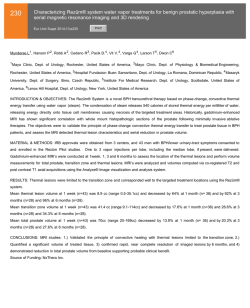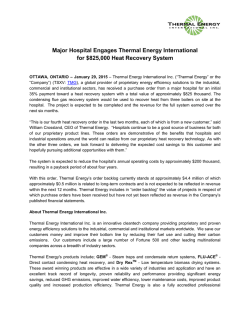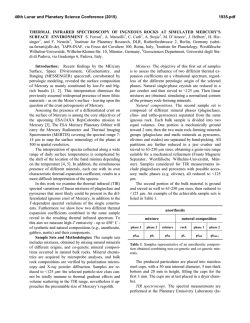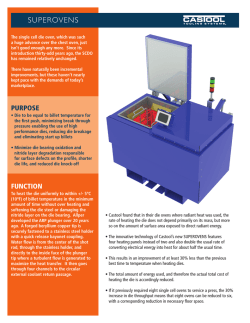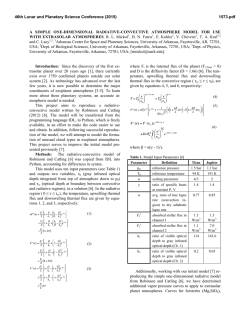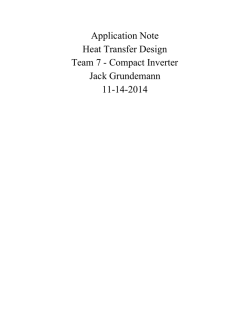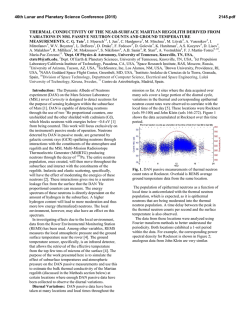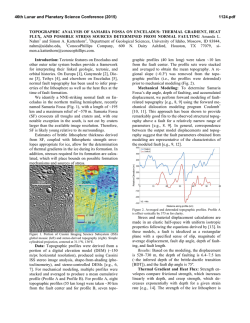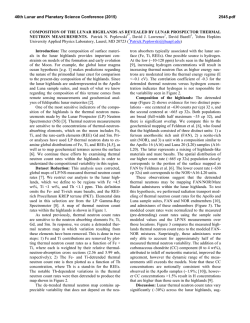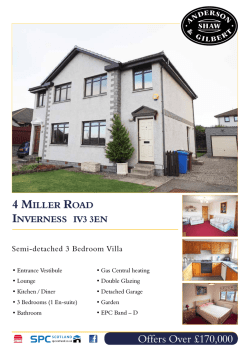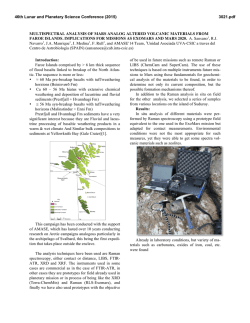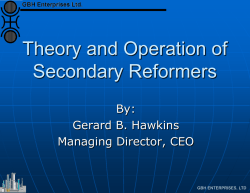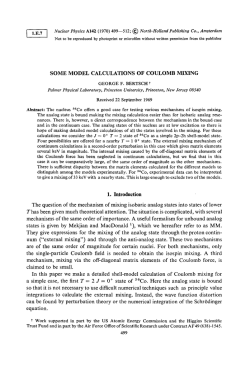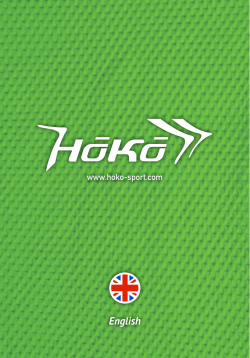
ONE-DIMENSIONAL THERMAL CONVECTION CALCULATION
46th Lunar and Planetary Science Conference (2015) 1093.pdf ONE-DIMENSIONAL THERMAL CONVECTION CALCULATION USING A MODIFIED MIXING LENGTH THEORY. S. Kamata1,2*, F. Nimmo1, and K. Kuramoto2 1Dept. Earth and Planetary Sciences, University of California Santa Cruz, 1156 High St, Santa Cruz, CA 95064, USA, 2Dept. Natural History Sciences, Hokkaido University, Kita-10 Nishi-8, Kita-ku, Sapporo, Hokkaido 060-0810, Japan (*[email protected]). Summary: We develop a one-dimensional scaling based on mixing length theory and compare with 3D calculation results. We find that the mean temperature (m) and Nusselt number (Nu) are overestimated and underestimated, respectively, when we use a conventional definition of the mixing length (l). We calculate m and Nu varying the definition of l under a wide variety of parameter conditions and derive a set of simple formulae for l that produces accurate values of m and Nu under steady-state isoviscous cases. Introduction: Thermal convection is considered to play a major role in the thermal evolution of planetary bodies since it can transport heat more efficiently than thermal conduction. A major issue for convection calculations is the high computational cost. Although computational speed has been greatly increased recently, parameterized convection codes are still applied to parameter studies [e.g., 1]. Parameterized convection is a box model using a scaling law for Nusselt number (Nu) and Rayleigh number (Ra) determined based on 3D calculations [e.g., 2]. Because this is a box model, a single representative value of physical properties needs to be specified to calculate Ra. Nevertheless, physical properties may vary largely with depth in the convective region, and it may be difficult to choose an appropriate value. A one-dimensional thermal convection calculation using mixing length theory (MLT) is free from such a problem. In this scheme, convective heat transport is expressed by, adding to the usual conduction equation, a term that appears when the thermal gradient exceeds the adiabatic gradient: 𝑑𝑇 1 𝑑 𝑑𝑇 𝑑𝑇 𝑑𝑇 𝜌𝐶 = 2 [𝑟 2 𝑘 + 𝑟 2 𝑘𝑣 ( − | )] + 𝜌𝑄 𝑑𝑡 𝑟 𝑑𝑟 𝑑𝑟 𝑑𝑟 𝑑𝑟 𝑎 where is density, C is specific heat, T is temperature, t is time, r is radial distance from the center, k is thermal conductivity, kv is effective thermal conductivity due to convection, Q is volumetric heating rate, and (dT/dr|a) is the adiabatic thermal gradient, respectively [e.g., 3]. The effective thermal conductivity kv depends on the mixing length l, which is usually assumed to be the distance to the nearest boundary (upper or lower boundary) of the convective region. The major advantage of MLT is its low calculation cost; because this is a one-dimensional scheme, the calculation cost is almost the same as that of conduction calculation. Another advantage is that all the parameters can be determined locally; this scheme can be easily applied to a case whose physical properties of the convective region vary significantly with depth. Consequently, the MLT scheme is suitable to apply parameter studies for thermal evolution of planetary bodies and has been applied to the early Earth [e.g., 3], early Mars [4], icy satellites [5], and super-Earths [6]. It has been shown that this scheme can well reproduce the Nu~Ra1/3 relation for an isoviscous, bottom heated case even though this scheme does not require Ra-Nu scaling laws [3]. However, a detailed comparison with recent 3D calculation results has not been conducted yet. In this study, we calculate the nondimensional mean temperature (m) and Nusselt number (Nu) under a wide variety of parameter conditions (i.e., Ra, curvature, and heat production rate), and compare with 3D calculation results [7]. We conduct examinations for bottom heated and mixed heating cases separately because scaling laws for m and for Nu are different between these cases. Mixing Length: Figure 1 shows l as a function of depth schematically. In order to minimize the number of free parameters, we assume that l = 0 at the upper and lower boundaries under all conditions and vary (1) the peak depth aH where l has the maximum value and (2) the maximum value bH of l. Here, H is the thickness of the convective region. We assume that l increases and decreases linearly with depth below and above z = aH, respectively. Previous studies define l as the distance to the nearest boundary: a = b = 0.5. Bottom Heated Case: Figure 2 shows m as a function of f, the ratio of the bottom radius to the upper radius; f = 0 and 1 indicates that the convective region Figure 1: The mixing length (l) as a function of depth (z). H is the thickness of the convective region. Free parameters are a (the peak depth) and b (the maximum value). 46th Lunar and Planetary Science Conference (2015) Figure 2: The mean temperature m as a function of f for bottom heated cases. Cross symbols and circles show results for the conventional (original) MLT (a = b = 0.5) and those for the adjusted MLT, respectively. is a sphere and a plane, respectively. For all f, the conventional MLT using a = b = 0.5 overestimates m, and the difference can be up to ~0.1. We also found that the conventional MLT underestimates Nu under all calculation conditions and that the relative error can be up to >60%. In order to obtain a set of simple formulae for a and b that leads to m and Nu close to those of 3D results, we calculated m and Nu varying values of a and b and then calculated the root mean square error of prediction (RMSEP). We found that the following equations lead to sufficiently small errors; the difference in m becomes <~0.015 (circles in Figure 2) and the relative error of Nu becomes <~15% . 𝑎 = 𝑓(1 − 𝑓/2) 𝑏 = 1.43 × 0.696𝑓 Mixed Heating Case: A similar analysis was carried out for mixed heating cases. We found that the conventional MLT scheme leads to errors of m and Nu that can be up to ~100% and ~60%, respectively (Figure 3). We conducted a non-linear regression analysis to obtain a set of simple formulae for a and b as functions of f and h. Here, h is the non-dimensional internal heating rate defined as h = QH2/(kT) where T is the temperature difference between the bottom and the top of the shell. We found that 𝑎 = 0.223𝑓 + 8.01 × 10−3 ℎ + 0.325 𝑏 = −0.733𝑓 2 + 0.858𝑓 + 1.17 × 10−2 ℎ + 0.716 gives errors <~15% (Figure 3), which are much smaller than those resulting from the conventional MLT. Discussion and Future Work: The obtained empirical equations of a and b for the bottom heated case are different from those derived for mixed heating conditions. This is not unexpected, since the scaling laws based on 3D calculations between these cases are also different [7]. 1093.pdf The actual convection occurs in 3D space, and lateral motion has a large effect on temperature near the boundary layers; the temperature immediately below the top (and cold) boundary layer, for example, is higher than the mean temperature, resulting in a negative thermal gradient [8]. Such a temperature profile cannot be reproduced as long as we use a simple definition of l (Figure 1). Nevertheless, the use of a more complex definition of l may lose one of the major advantages of the MLT scheme that the calculation cost is very small. The viscosity of silicates and ices depends strongly on temperature. For this initial study, however, we consider only isoviscous cases. A further study considering temperature-dependent viscosity is needed. Acknowledgments: We thank Y. Abe, J. Besserer, J. Kimura, and T. Yanagisawa for fruitful discussions. This work was supported by JSPS Grant-in-Aid for JSPS Fellows. References: [1] Grott et al. (2011) EPSL, 307, 135-146. [2] Solomatov (1995) Phys. Fluids, 7, 266-274. [3] Abe (1995) The Earth's Central Part: Its Structure and Dynamics, pp. 215-235. [4] Senshu et al. (2002) JGR, 107, doi:10.1029/ 2001JE001819. [5] Kimura et al. (2009) Icarus, 202, 216224. [6] Tachinami et al. (2011) ApJ, 726, 70-88. [7] Deschamps et al. (2010) GJI, 182, 137-154. [8] McKenzie et al. (1974) J. Fluid Mech., 62, 465-538. Figure 3: The comparison of the mean temperature m ((a) and (b)) and Nusselt number Nu ((c) and (d)) for mixed heating cases. Here, h is the non-dimensional heating rate. Errors in m and Nu for the conventional (original) MLT are up to ~100% and ~60%, respectively. Those for the adjusted MLT are reduced to <~15%.
© Copyright 2025
